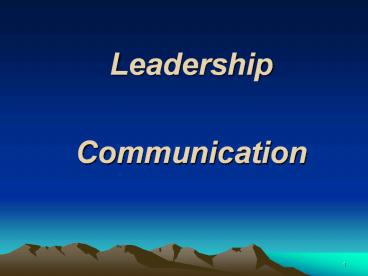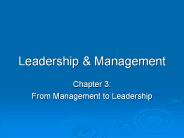Leadership - PowerPoint PPT Presentation
1 / 38
Title:
Leadership
Description:
Leadership Communication * Question #4 ___ A. When I have a negative opinion or comment, I just say it ___ B. When I have a negative opinion or comment, I lead in ... – PowerPoint PPT presentation
Number of Views:45
Avg rating:3.0/5.0
Title: Leadership
1
- Leadership
- Communication
2
PROBLEM IN COMMUNICATION
- The single biggest problem in communication is
the illusion it has taken place. - George Bernard Shaw
3
- LACK OF SENDING AND RECEIVING
DIRECTIONS
4
Communication
A process by which information and understanding
are transferred between a sender and a receiver
5
Communication Goals
6
Ex. 9.1 A Basic Model of the Communication Process
Potential noise and distortion
Leader encodes message
Receiver decodes message
Channel
Return message encoded and sent
Feedback Loop
7
Barriers to communication
- Noise
- Inappropriate medium
- Assumptions/Misconceptions
- Emotions
- Language differences
- Cultural differences
- Poor listening skills
- Use of jargon
- Distractions
8
Ex. 9.2 The Leader as Communication Champion
Purpose Directed Direct attention to
vision/values, desired outcomes use persuasion
Leader as Communication Champion
Strategic Conversation Open climate
Listening Discernment Dialogue
Internal and external sources
Methods Use rich channels Stories and
metaphors Informal communication
9
Ex. 9.3 Why Open the Communication Channels?
- An open climate is essential for cascading
vision, and cascading is essential because - Natural
Law 1 - You Get What You talk about
- A vision must have ample air time in an
organization. A vision must be shared and
practiced by leaders at every opportunity.
10
Natural Law 2
- The Climate of an Organization is a
- Reflection of the Leader
- A leader who doesnt embody the vision and values
doesnt have an organization that does.
11
Natural Law 3
- You Cant Walk Faster Than One Step at a Time
- A vision is neither understood nor accepted
overnight. Communicating must be built into
continuous, daily interaction so that over time
followers will internalize it.
12
Open Communication
- Asking questions
- Leader-centered
- Follower-centered
- Listening
- Engaged listening
13
Ex. 9.4 Ten Keys to Effective Listening
14
Ex. 9.4 (contd.)
15
Open Communication
- Discernment
- Listening in which a leader detects
unarticulated messages hidden blow the surface of
spoken interaction. - Dialogue
- Active sharing and listening in which people
explore common ground and grow to understand each
other and share a world view.
16
Ex. 9.5 Dialogue and Discussion The Differences
Conversation
Lack of understanding, disagreement, divergent
points of view, evaluate others
Dialogue
Discussion
Reveal feelings Explore assumptions Suspend
convictions Build common ground
State positions Advocate convictions Convince
others Build oppositions
Result
Result
Short-term resolution Agreement by
logic Opposition beaten down Mind-sets held onto
Long-term, innovative solutions Unified
group Shared meaning Transformed mind-sets
17
Communication Champion
- Establish credibility
- Build goals on common ground
- Make your position compelling to others
- Connect emotionally
18
Communication Apprehension
- An individuals level of fear or anxiety
associated with either real or anticipated
communication with another person or persons.
19
Forms of Communications
20
Formal Communication Strategy
- Who Source/Audience
- What Content
- When Delivery Effective Date
- Where Impacts/Contacts/Additional Information
21
Ex. 9.6 A Continuum of Channel Richness
Electronic mail, IM, Web, intranet
Face-to-face verbal
Formal report
Disadvantages Impersonal One-way Slow feedback
Advantages Personal Two-way Fast feedback
High channel richness
Low channel richness
Disadvantages No record Spontaneous Dissemination
hard
Advantages Provides record Premeditated Easily
disseminated
Memos, letters
Telephone
22
Effective Use of Electronic Communication Channels
- Combine high-tech with high-touch
- Consider the circumstances
- Read twice before you hit the send button
- Know what is off limits
23
Ex. 9.7 Dos and Donts of Electronic Mail
(abridged)
- Do
- Use e-mail to set up meetings, to recap spoken
conversations, or to follow up on information
already discussed face-to-face. - Keep e-mail messages short and to-the-point.
Many people read e-mail on handheld devices,
which have small screens. - Use e-mail to prepare a group of people for a
meeting. For example, it is convenient to send
the same documents to a number of people and ask
them to review the materials before the meeting. - Use e-mail to transmit standard reports.
- Act like a newspaper reporter. Use the subject
line to quickly grab the readers attention.
24
Ex. 9.7 (contd.)
- Dont
- Use e-mail to discuss something with a colleague
who sits across the aisle or down the hall from
you. Take the old-fashioned approach of speaking
to each other. - Lambaste a friend or colleague via e-mail and
especially dont copy others on the message. - Use e-mail to start or perpetuate a feud.
- Write anything in an e-mail you wouldnt want
published in a newspaper. E-mail with sensitive
or potentially embarrassing information has an
uncanny way of leaking out.
25
Do you use the correct channel ?
- http//www.youtube.com/watch?vEoMkJ87uMBU
26
Communication Across Continents
27
Stories and Metaphors
- Leaves clear lasting impressions with followers
- Increases meaning for leaders message
- Evokes both visual imager and emotion
- Helps people connect with the message and the key
values
28
Informal Communication
- Leaders are watched (nonverbal communication)
- Appearance
- Behavior
- Actions
- Attitudes
- Selection of communication channel
- Management by Walking Around
29
Non-Verbal Communication
- http//www.youtube.com/watch?vP5EnOoI-ePcfeature
related
30
Nonverbal Behaviors
- Eye Contact
- Facial Expressions
- Gestures
- Posture and Body Orientation
- Proximity
- Vocal (other than words)
31
Question 1
Assessment Exercise
___ A. When conversing with others, I usually
do most of the talking ___ B. When conversing
with others, I usually let the other person do
most of the talking ___ C. When conversing
with others, I try to equalize my participation
in the conversation
32
Question 2
- ___ A. I make eye contact while conversing
- ___ B. I sometimes make eye contact while
conversing - ___ C. I never make eye contact while
conversing
33
Question 3
- ___ A. When I'm listening to the speaker, I
often cross my arms over my chest - ___ B. When I'm listening to the speaker, I
often lean back and turn my body away from the
speaker - ___ C. When I'm listening to the speaker, I
often lean slightly forward and face my body
toward the speaker
34
Question 4
- ___ A. When I have a negative opinion or
comment, I just say it - ___ B. When I have a negative opinion or
comment, I lead in with a positive comment first - ___ C. When I have a negative opinion or
comment, I say nothing
35
Question 5
- ___ A. When I disagree with a person, I listen
first, ask questions for clarification, then
disagree non-judgmentally - ___ B. When I disagree with a person, I
quickly point out the person is wrong and why - ___ C. When I disagree with a person, I say
little or nothing
36
Peter Northouses states( Peter Guy Northouse,
is Professor of Communication at Western Michigan
University )
- When Leaders and Followers have good exchanges,
they feel better, accomplish more and the
organization prospers-Northouse
37
Communicating in a Crisis
- Stay calm listen harder
- Be visible
- Tell the truth
- Communicate the vision for the future
38
Benefits of Good Communication
- Quicker problem solving
- Better decision making
- Steady work flow
- Strong business relations
- Better professional image































